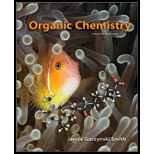
Concept explainers
The stereochemistry of the products of reduction depends on the reagent used, as you learned in Sections 20.5 and 20.6. With this in mind, how would you convert
Want to see the full answer?
Check out a sample textbook solution
Chapter 20 Solutions
Organic Chemistry - With Access (Looseleaf) (Custom)
- Draw the structure of each product from the reaction of benzene with 2-chloro-1-methylcyclohexane using AlCl 3 as the catalyst and Identify the major product.arrow_forwardThe stereochemistry of the products of reduction depends on the reagent used, as you learned in Sections 20.5 and 20.6. With this in mind, how would you convert 3,3-dimethylbutan-2-one [CH3COC(CH3)3] to: (a) racemic 3,3-dimethylbutan-2- ol [CH3CH(OH)C(CH3)3]; (b) only (R)-3,3-dimethylbutan-2-ol; (c) only (S)-3,3-dimethylbutan-2-ol?arrow_forwardExplain why (S)-2-butanol forms a racemic mixture when it is heated in sulfuric acid.arrow_forward
- Which alcohols can be prepared as a single product by hydroboration–oxidation of an alkene? Which alcohols can be prepared as a singleproduct by the acid-catalyzed addition of H2O to an alkene?arrow_forwardChemical compound A is an alkene that when treated with ozone followed by treatment of Zn in HOAc produces only (CH3CH2CH2) 2C = O. What is the structure of A? If A is reacted with peroxyacetic acid, what product would be obtained? Write the corresponding structure. Is this substance optically active? Please include a detailed explanation.arrow_forwardWhen carbonyl compounds are reduced with a reagent such as LiAlH4 or NaBH4 and a new stereogenic center is formed, what will the composition of the product mixture be? Forms more of one enantiomer than another because of steric reasons around the carbonyl Forms more of one enantiomer than another depending on the temperature of the reaction Forms different products depending on the solvent used Forms a racemic mixture of the two possible enantiomersarrow_forward
- Explain the process of Conversion of hexan-2-ol to other compounds ?arrow_forward4-Chloro-2-pentene has a double bond that can have either the E or the Z configuration and a stereogenic center that can have either the R or the S configuration. How many stereoisomers arepossible altogether? Draw the structure of each, and group the pairs of enantiomers.arrow_forwardDraw the skeletal structure of 3-chloro-1,1-cyclopentanedicarboxylic acidarrow_forward
- Draw the organic products formed when cyclopentene is treated withfollowing reagent. [1] OsO4 + NMO; [2] NaHSO3, H2Oarrow_forwardPredict the products/ identify the reactants in the following reactions- draw the structure and show the stereochemistry of the products. If no products are formed, pls write NR.arrow_forwardExplain the Preparation of Dihalocarbenes ?arrow_forward
